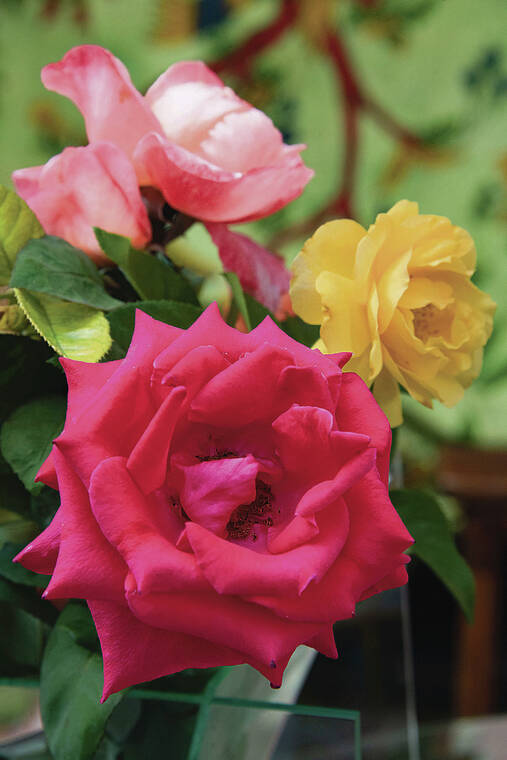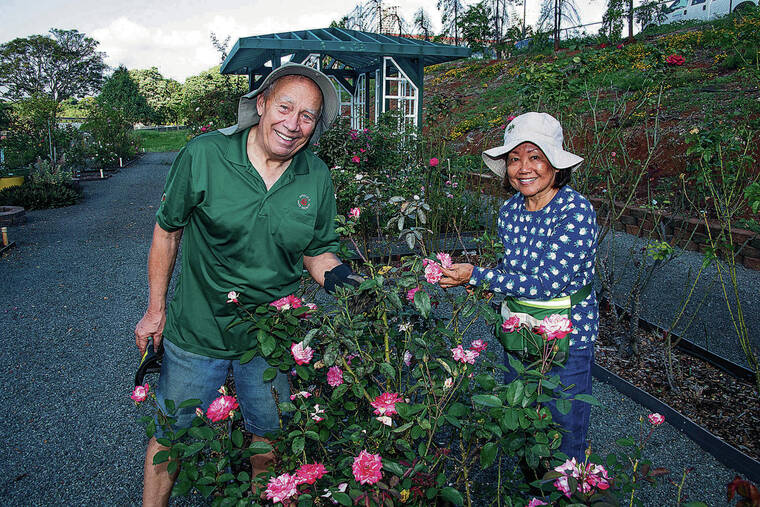Honolulu Rose Society offers classes for budding gardeners

CRAIG T. KOJIMA / CKOJIMA@STARADVERTISER.COM
These roses were plucked from among the 80-plus varieties planted in the Honolulu Rose Society garden.

CRAIG T. KOJIMA / CKOJIMA@STARADVERTISER.COM
Volunteers Bob Speer and Adela Rhoades help keep the Honolulu Rose Society’s garden thriving at the Urban Garden Center in Pearl City.


Myrna Cariaga, president of the Honolulu Rose Society, was once too intimidated to grow roses, like many who thought they were too high maintenance or couldn’t survive in Hawaii’s hot climate.
But that was 22 years ago. She took a chance on two bargain-priced plants — “I just wanted to see for myself” — and got hooked when they bloomed and smelled heavenly. Cariaga said she just followed instructions, but acknowledged a little beginner’s luck may have helped. That led to trying a dozen different roses and at one point, she had over 100 plants.
“Some worked in my yard, some didn’t. It’s a humbling experience,” she said about learning what roses did not do well in spite of her greatest intentions. But with thousands of varieties to choose from, it didn’t hurt to keep trying to see what would thrive.
“It’s not the failures, it’s the learning process,” she said.
Now a certified master rosarian, Cariaga will teach the first of four Saturday classes of the club’s 8th annual Rose School from March through June at the Urban Garden Center in Pearl City. They’re very hands-on and filled with camaraderie, she said.
The society was invited to establish a rose garden in 2009 by the Urban Garden Center under the University of Hawaii’s College of Tropical Agriculture and Human Resources, mainly to educate the public. With hefty support from mainland breeders and clubs during its formation, the garden is now filled with over 280 plants of more than 80 varieties. The club’s 90-plus members, 25 of them lifetime, voluntarily maintain the 1-acre garden.
Don't miss out on what's happening!
Stay in touch with breaking news, as it happens, conveniently in your email inbox. It's FREE!
Bob Speer, who helped construct the garden and is the director of maintenance, said it’s a fun and challenging project that helps to teach the community what tricks and methods work.
Roses generally thrive in cool weather, so they’re more difficult to grow here, but most of the club’s plants are hybrids designed for a subtropical climate, he said. But with no freezing temperatures to kill off the pests, local gardeners are battling bugs and diseases year-round.
Speer, who earned a UH Master Gardener certificate in 2006 after retiring from the military, said Hawaii’s heavy soil is not favorable to roses. It’s most important to amend the soil with compost, which comprises 50% of the club’s rose beds, he said. The locally produced compost is excellent for adding carbon and improving drainage, and perlite helps loosens the soil. Bone meal and sulfur are added to the mix to supply key nutrients to the roses.
Cariaga said the garden is ever-evolving: Roses that don’t do well are replaced with sturdier varieties each year. As an example of Hawaii’s diverse microclimates, even within the same districts, she said the Pearl City garden is arid and therefore more challenging, but the cooler, wetter weather of the Palisades mountains is easier on roses.
To boost their confidence, she recommended beginners start with modern varieties that are more resistant to disease and infestation.
Top Gun is a very bushy, red rose that is “hard to kill; it grows like a weed. I love it.” It doesn’t have the classic spiral blooms of roses found at the florists, but instead has single-layer petals. Mister Lincoln, another red rose, has spiral blossoms and is very fragrant. The Lokelani, known as a Hawaiian rose since missionaries brought it here, is bushy, smells like a mountain apple, and turns from pink to red.
Cariaga shared these tips for basic care:
>> Put the roses in full sun, at least four hours, ideally six to eight.
>> Plant in well-drained soil in a pot or the ground; add compost or other amendments as necessary.
>> Water only when needed. Touch the soil to check the moisture level or lift the pot to gauge its water content by how heavy it is.
>> Fertilize after every bloom. After pruning the branches, use fertilizer, either all-purpose or one specifically for roses; just be consistent. Be sure to follow instructions on the label.
>> Pesticides should be used only when there is a true infestation; commercial products work better than homemade formulas. The first line of defense is a strong jet stream of water, particularly under the leaves; but if pests still stick, gently scrape them off with a soft brush. A detailed list of pest and disease remedies is on the club’s website.
Cariaga said, “Roses are the most responsive plant, as they will tell you what’s happening to them. If you fertilize, they will bloom; if you don’t protect the plant, they will have disease. I will always encourage anyone to grow roses. It’s a gratifying and humbling experience.
“The simple act of maintaining your roses keeps your mind active and sharp as there are many factors that influence the growth. Plus, there is a sense of pride in sharing beautiful roses that you’ve grown.”
—
8th Annual HRS Rose School
Classes will cover how to plant, fertilize, prune and maintain roses.
>> When: 9:30 a.m. to noon, March 25, April 22, May 27 and June 24
>> Where: Urban Garden Center, 955 Kamehameha Highway, Pearl City
>> Cost: $45 (members) or $60 (includes a one-year membership fee); includes materials, a miniature rose plant to work on during class, and a bonus plant.
>> Info: honolulurose society.org
Is there a gardening topic you’d like to read about in the Garden Variety column? Email Pat Gee at pgee@staradvertiser.com with your request.



